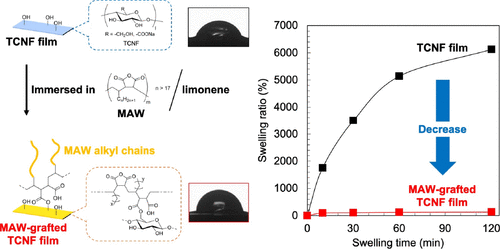当前位置:
X-MOL 学术
›
ACS Appl. Polym. Mater.
›
论文详情
Our official English website, www.x-mol.net, welcomes your
feedback! (Note: you will need to create a separate account there.)
Highly Water-Tolerant TEMPO-Oxidized Cellulose Nanofiber Films Using a Maleic Anhydride/Wax Copolymer
ACS Applied Polymer Materials ( IF 4.4 ) Pub Date : 2021-08-10 , DOI: 10.1021/acsapm.1c00573 Toshiki Tamiya 1 , Raghav Soni 1 , Yu-I Hsu 1 , Hiroshi Uyama 1
ACS Applied Polymer Materials ( IF 4.4 ) Pub Date : 2021-08-10 , DOI: 10.1021/acsapm.1c00573 Toshiki Tamiya 1 , Raghav Soni 1 , Yu-I Hsu 1 , Hiroshi Uyama 1
Affiliation

|
In this article, a highly water-durable film based on (2,2,6,6-tetramethylpiperidin-1-yl)oxyl (TEMPO)-oxidized cellulose nanofibers (TCNFs) was prepared through a facile process using maleic anhydride/wax copolymer (MAW)/limonene solution. In the last few decades, the expansion of thermoplastic consumption has induced serious environmental issues like soil and marine pollutants and energy resource depletion. As a replacement of existing resins, the TCNF film is one of the most promising materials because it has high mechanical properties along with lightweight, good chemical and thermal stabilities under dry conditions, and cellulose as a starting material, which is the most abundant organic polymer on earth . However, the TCNF film under humid conditions shows low mechanical strength, which is not enough to use it as a commodity item. To improve the water durability of TCNF, we attempted to develop a surface modification technique with MAW/limonene solution. By immersing in MAW/limonene solution, the water contact angle of TCNF was increased from 65° to 80°; also, its water swelling ratio was decreased from ∼6000% to 60%. Moreover, MAW-modified TCNF (M-TCNF) showed high mechanical strength (elastic modulus ∼1.8 GPa and tensile strength ∼52 MPa) in a swollen state. These results demonstrate the improvement in the water durability of the TCNF surface-modified with MAW. This contribution can help to expand the application of TCNF to various fields such as food packaging, water purification, and so on.
中文翻译:

使用马来酸酐/蜡共聚物的高耐水性 TEMPO 氧化纤维素纳米纤维膜
在本文中,通过使用马来酸酐/蜡共聚物的简便方法制备了基于 (2,2,6,6-四甲基哌啶-1-基)氧基 (TEMPO)-氧化纤维素纳米纤维 (TCNFs) 的高度耐水薄膜(MAW)/柠檬烯溶液。在过去的几十年里,热塑性塑料消费的扩大引发了严重的环境问题,如土壤和海洋污染物以及能源资源枯竭。作为现有树脂的替代品,TCNF 薄膜是最有前途的材料之一,因为它具有高机械性能、重量轻、干燥条件下良好的化学和热稳定性,以及作为起始材料的纤维素,这是最丰富的有机聚合物在地球上 。然而,TCNF薄膜在潮湿条件下表现出较低的机械强度,不足以作为商品使用。为了提高 TCNF 的耐水性,我们尝试使用 MAW/柠檬烯溶液开发表面改性技术。通过浸泡在MAW/柠檬烯溶液中,TCNF的水接触角从65°增加到80°;此外,其水溶胀率也从 6000% 降低到 60%。此外,MAW 改性的 TCNF(M-TCNF)在溶胀状态下显示出高机械强度(弹性模量~1.8 GPa 和拉伸强度~52 MPa)。这些结果证明了用 MAW 表面改性的 TCNF 的耐水性的改进。这一贡献有助于将 TCNF 的应用扩展到食品包装、水净化等各个领域。TCNF的水接触角从65°增加到80°;此外,其水溶胀率也从 6000% 降低到 60%。此外,MAW 改性的 TCNF(M-TCNF)在溶胀状态下显示出高机械强度(弹性模量~1.8 GPa 和拉伸强度~52 MPa)。这些结果证明了用 MAW 表面改性的 TCNF 的耐水性的改进。这一贡献有助于将 TCNF 的应用扩展到食品包装、水净化等各个领域。TCNF的水接触角从65°增加到80°;此外,其水溶胀率也从 6000% 降低到 60%。此外,MAW 改性的 TCNF(M-TCNF)在溶胀状态下显示出高机械强度(弹性模量~1.8 GPa 和拉伸强度~52 MPa)。这些结果证明了用 MAW 表面改性的 TCNF 的耐水性的改进。这一贡献有助于将 TCNF 的应用扩展到食品包装、水净化等各个领域。
更新日期:2021-09-10
中文翻译:

使用马来酸酐/蜡共聚物的高耐水性 TEMPO 氧化纤维素纳米纤维膜
在本文中,通过使用马来酸酐/蜡共聚物的简便方法制备了基于 (2,2,6,6-四甲基哌啶-1-基)氧基 (TEMPO)-氧化纤维素纳米纤维 (TCNFs) 的高度耐水薄膜(MAW)/柠檬烯溶液。在过去的几十年里,热塑性塑料消费的扩大引发了严重的环境问题,如土壤和海洋污染物以及能源资源枯竭。作为现有树脂的替代品,TCNF 薄膜是最有前途的材料之一,因为它具有高机械性能、重量轻、干燥条件下良好的化学和热稳定性,以及作为起始材料的纤维素,这是最丰富的有机聚合物在地球上 。然而,TCNF薄膜在潮湿条件下表现出较低的机械强度,不足以作为商品使用。为了提高 TCNF 的耐水性,我们尝试使用 MAW/柠檬烯溶液开发表面改性技术。通过浸泡在MAW/柠檬烯溶液中,TCNF的水接触角从65°增加到80°;此外,其水溶胀率也从 6000% 降低到 60%。此外,MAW 改性的 TCNF(M-TCNF)在溶胀状态下显示出高机械强度(弹性模量~1.8 GPa 和拉伸强度~52 MPa)。这些结果证明了用 MAW 表面改性的 TCNF 的耐水性的改进。这一贡献有助于将 TCNF 的应用扩展到食品包装、水净化等各个领域。TCNF的水接触角从65°增加到80°;此外,其水溶胀率也从 6000% 降低到 60%。此外,MAW 改性的 TCNF(M-TCNF)在溶胀状态下显示出高机械强度(弹性模量~1.8 GPa 和拉伸强度~52 MPa)。这些结果证明了用 MAW 表面改性的 TCNF 的耐水性的改进。这一贡献有助于将 TCNF 的应用扩展到食品包装、水净化等各个领域。TCNF的水接触角从65°增加到80°;此外,其水溶胀率也从 6000% 降低到 60%。此外,MAW 改性的 TCNF(M-TCNF)在溶胀状态下显示出高机械强度(弹性模量~1.8 GPa 和拉伸强度~52 MPa)。这些结果证明了用 MAW 表面改性的 TCNF 的耐水性的改进。这一贡献有助于将 TCNF 的应用扩展到食品包装、水净化等各个领域。











































 京公网安备 11010802027423号
京公网安备 11010802027423号